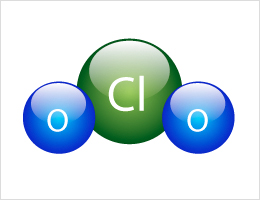VASU designs and manufactures Chlorine dioxide Generators CLOGEN of various capacities based on oxygen demand, application type and overall cost effectiveness. VASU has developed generators of all types: from simple generators with pumps and control panel to fully integrated systems, our generators are customized to meet every client need.
With more than 400 installations all over India and also in Asia / Africa, VASU is one of the largest manufacturers of the generator in India.
Chlorine dioxide is usually generated by one of three methods, each of which are both efficient and cost effective viz. by Chlorine Gas method, Sodium Hypochlorite method and by acid activation of Sodium Chlorite. The three methods are explained below in option I, Option II and Option III. In each method Chlorine Dioxide is generated at site through a specialized ClO2 generator.
OPTION I: Chlorine Gas Method
In the generator unit, Chlorine dioxide is generated by a chemical reaction that occurs when a controlled volume of precursor chemical (NaClO2)is combined with a water stream containing Chlorine.
Following is the reaction for generation of ClO2 by Chlorine gas method
- 2NaClO2 + Cl2 → 2ClO2 + 2NaCl
OPTION II: Sodium Hypochlorite Method
In the generator unit, Chlorine dioxide is generated by a chemical reaction that occurs when a controlled volume of precursor chemical (NaClO2) is combined with a water stream containing Hydrochloric Acid.
Following is the reaction for generation of ClO2 by HCl method
- 5 NaClO2 + 4 HCl = 4ClO2 + 5 NaCl + 2H2O
OPTION III: Acid Activation of Sodium Hypochlorite Method
In the generator unit, Chlorine dioxide is generated by a chemical reaction that occurs when a controlled volume of precursor chemical (NaClO2) is combined with a water stream containing sodium hypochlorite and a Hydrochloric Acid.
Following is the reaction for generation of ClO2
- 2NaClO2 + NaOCl + 2HCl → 2ClO2 + 3NaCl + H2O


